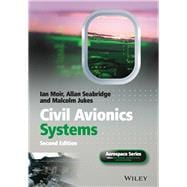Civil Avionics Systems, Second Edition, is an updated and in-depth practical guide to integrated avionic systems as applied to civil aircraft and this new edition has been expanded to include the latest developments in modern avionics. It describes avionic systems and potential developments in the field to help educate students and practitioners in the process of designing, building and operating modern aircraft in the contemporary aviation system.
Integration is a predominant theme of this book, as aircraft systems are becoming more integrated and complex, but so is the economic, political and technical environment in which they operate.
Key features:
• Content is based on many years of practical industrial experience by the authors on a range of civil and military projects
• Generates an understanding of the integration and interconnectedness of systems in modern complex aircraft
• Updated contents in the light of latest applications
• Substantial new material has been included in the areas of avionics technology, software and system safety
The authors are all recognised experts in the field and between them have over 140 years’ experience in the aircraft industry. Their direct and accessible style ensures that Civil Avionics Systems, Second Edition is a must-have guide to integrated avionic systems in modern aircraft for those in the aerospace industry and academia.








